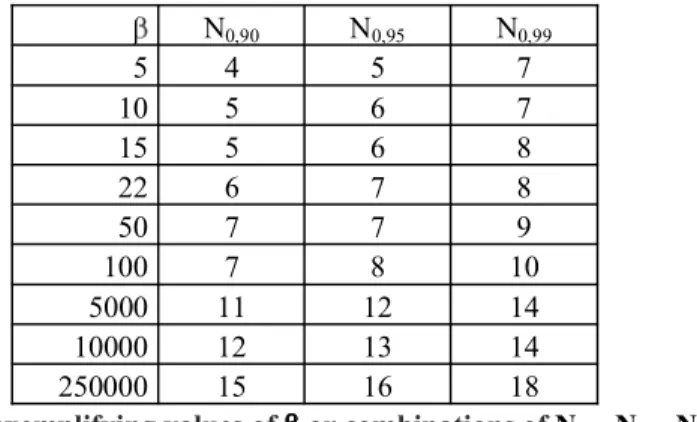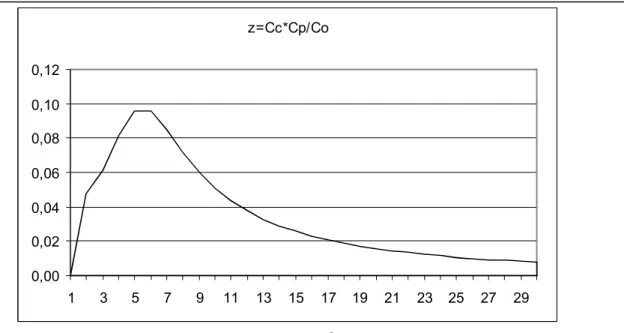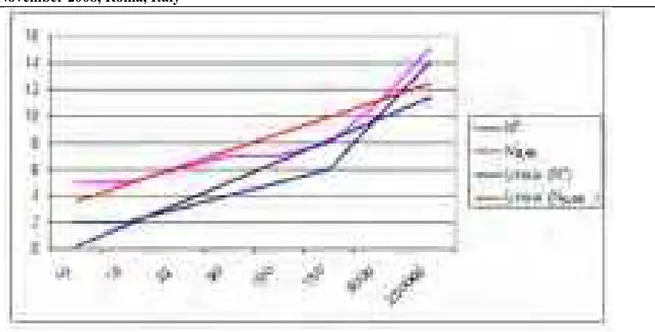A model for R&D project management: how does the number of team members
influence the project performance?
Francesco Fusco Girard
“Tor Vergata” University of Rome Dept. of Enterprise Engineering
Massimiliano M. Schiraldi
1it is not always possible - or economically advisable - to adjust the number of team members when the project is already in progress, unless previously planned. This necessity might be particularly felt for RD (Research and Development) projects and NDP (New Product Development) project, since both are characterised by variability in results and objectives. A correct determination of the number of members, right from the planning phase, may help to meet the forecasts of time and costs, and furthermore, the stability of the team is usually an important factor for success.
“Tor Vergata” University of Rome Dept. of Enterprise Engineering
Abstract
Determining the optimal number of team members in projects is a key factor in Project Management. The choices related to projects’ team dimensions are usually based upon the Project Managers’ previous experience and it presents itself with little structure, as it is believed that the structural approach does not take into account immaterial aspects, such as creativity, which is difficult to measure and therefore hard to manage.
In such a context, the aim of this paper is to provide project managers with guidelines useful to determine the ideal dimensions of a project team along the lines of a formal approach and it does so by considering how numerosity may affect the effort of coordination and communication among members, production capacity and creative skills, especially when the latter constitutes an essential factor, as in Research and Development (R&D) projects.
To this aim a model is put forward which presents itself quite straightforwardly from the mathematical point of view and the results of which can be easily interpreted. An effort has been made to reduce to a minimum the number of free parameters, which might arbitrarily characterize th functions utilized. Therefore, on the only free parameter a Sensitivity Analysis has been conducted which has shown a certain robustness of the model, thus allowing to get to interesting conclusions about the determination of the ideal dimensions of a project team engaged in Research and Development activities.
Keywords
: dimensions of project team, creativity, productivity and human resources management, R&D Projects.1. Introduction
Determining the optimal number of team members in projects is of particular interest for the management of project as:
there exist typologies of projects in which the addition of a member may entail an increase of work capacity, which can be measured just in terms of an increase in the working loads, and there are other and different typologies of projects (R&D and NPD, for instance) in which the addition of a team member could bring about a huge increase in effectiveness, as the contribution is measured in terms of creativity and potential for generating new ideas. The link between productivity of the team and its members is not an elementary one: more people perform a greater work capacity, though coordinating them is more and more difficult, and in different ways they bring the value of “creativity” to the project.
Notwithstanding such complexity, the decision on the dimension of a team is almost exclusively based upon the previous experience of the Project Manager who, most of the times, is mostly concerned with combining budget constraints and project requirements.
This decision-making process is very often discharged arbitrarily on a purely subjective basis and is little structured from a logical-formal point of view. Much as it is believed that an arid mathematical formalisation does not take into due account any immaterial aspects, such as creativity (it being difficult to define, measure and therefore hard to control), one often wonders how useful can a total lack of a structured approach be for this purpose.
The present paper moves towards such perspective with a view to provide the Project Manager with a formal and very comprehensible tool, the results of which can easily be interpreted and shared.
1
9 - 11 November 2008, Roma, Italy
2. Model Analysis
Said n the number of team members, the analysis of the impact of the n value on the project will be carried out through the following criteria:
Coordination and Organisation Effort Production Capacity
Creative Capacity
Concerning these criteria, later on relations will be described which are assumed might link project team performance to n members numerosity.
2.1 Organisational Effort
Besides the cost of human resources, coordination difficulties undoubtedly represent the main reason for keeping the dimensions of a team limited. In fact, when the number of members is increased, it is necessary to make a greater organisational effort in order to:
Avoid that any of the team member gets cut out of the information flow (Zenger and Lawrence, 1989); Manage complex workflows;
Coordinate communication and information flow among a greater number of knots.
In the light of the above-mentioned, it has been deemed that the organisational effort should be represented as depending on the number of possible connections among the various knots /members of the team, i.e. the simple combinations of the n elements taken 2 by 2 without considering their order. Such hypothesis finds its proper confirmation in R&D project teams, in which the organisation of workgroups is typically flat. In a workgroup organised along rigidly hierarchical lines, in fact, information exchange modalities cannot be represented on a completely connected graph, but on a tree. Differently, for projects in which a creative contribution on the part of all members is required (besides R&D projects, also groups carrying out problem-solving activities have such need), generally it is important that all members are rapidly informed about the entire status of the project, and that all members may more or less freely express their opinion, thus contributing to its evolution.
Therefore, said CO the organisational effort, this is considered to vary with n according to the following equation: Co= n! / (2!*((n-2)!)) (1) 2.2 Production Capacity.
All traditional theories on Project Management consider a positive but decreasing relation between a team’s work capacity and the number of its members. By “Production Capacity” is here meant the capacity to carry out all the operations for which the creativity required can be regarded as negligible compared to technique. Typically such capacity is measured in working hours. The course of the production capacity according to the number of team members is influenced by considerations regarding:
The decrease of the individual effort following the increase of the team dimensions (Bray and others, 1978). In fact, on increasing the dimensions of the team, the number of non-participating members increases too and therefore it becomes more difficult for members to contribute with their knowledge, their ability and experience in all their potential.
The law of decreasing performance. In a generic productive system, to any contribution of any factor (in this case, labour) does not match a proportionally growing production increase.
Obviously the explanations here described are correlated. In the light of such considerations, the production capacity has been represented through an uncomplicated logarithmic function according to the equation:
Cp= ln (n) (2) 2.3 Creative Capacity
It represents the capacity to carry out activities in which creativity has an essential role compared to the mere performing of pre-defined steps. There are several definitions of creativity. One of the most famous is by H. Poincarè, who defined it as new and useful combination of existing elements. If it is not possible to forecast either novelty or usefulness, the definition given helps to recognise in communication a fundamental role for the development of creative capacities. Assessing a function that may describe the course of any creative capacity in relation to numerosity is a very complicated aspect. In this paper the following considerations have been taken into account:
a) the creativity of a group is considered as something more than the plain aggregate of the creativity of every single member in a team (Taggar, 2002), and therefore a linear rule would have led to underestimating the influence of the number of members on its performance.
b) from a certain number of members onwards the marginal contribution to creativity given by the addition of a new member becomes gradually lower. This consideration can be substantiated by leading it back to the rule that experimentally describes the number of new ideas generated by the focus group, when varying the number of operated groups (Ulrich, Eppinger, 2007), a rule which shows an increase less than proportional.
According both the consideration in a) and b), we can hypothesise a sigmoidal course for the function that links a team’s creative capacity to the number of members. Such function describes, as a matter of fact, the phenomenon of the marginal decreasing performance after its point of inflection, consistent with what has been theoretically reported in point a). Beyond points of inflection, therefore, on increasing team members, added skills can be ever increasingly superimposed, which is consistent with consideration b.
For this reason we have chosen to represent the influence of n on creativity as:
Cc= 1/(1+ *e-n) (3) 2.4 Objective Function
Given the above-mentioned hypotheses, the objective function, to be maximised, can simply be built by combining the three afore-said functions in such a way that team performance is directly proportional to the product of the capacities and inversely proportional to the coordination and communication difficulties
Z= Cc*Cp/Co (4)
3. Model Optimization and Analysis
As said before, the model has been purposely built in a simplified manner in order to reduce to a minimum the number of free parameters. The only degree of freedom is represented by the parameter relating the sigmoidal course of the function that describes creativity capacity. The value of the parameter determines the limit beyond which the addition of a new member affects creative capacity in an ever-decreasing manner. If the multiplicity of competences is meant as an indicator of the complexity of a project, then the parameter can be considered as an indicator of the complexity of a project: as for complex projects, it can be said that a saturation effect of the creative capacities can be found in an elevated number of members, whereas for less complex projects, the capacities of the single members will be such as to saturate creativity sooner, as their competences will complete sooner the set of necessary competences and, after a certain level, they will overlap the ones already present.
In detail, we will define
N0,90 the value of n beyond which the addition of a team member will determine increases in creativity inferior to 10%
N0,95 the value of n beyond which the addition of a team member will determine increases in creativity inferior to 5%
N0,99 the value of n beyond which the addition of a team member will determine increases in creativity inferior to 1%
Below, in Table 1, some representative values of N0,90 N0,95 N0,99 and the corresponding values of the parameter are described N0,90 N0,95 N0,99 5 4 5 7 10 5 6 7 15 5 6 8 22 6 7 8 50 7 7 9 100 7 8 10 5000 11 12 14 10000 12 13 14 250000 15 16 18
Table 1: exemplifying values of or combinations of N0,90 N0,95 N0,99
For a project of medium complexity, the following configuration can be estimated =100 (N0,90 = 7; N0,95 = 8; N0,99 = 10) the function to be optimized will have the course described in the illustration below:
9 - 11 November 2008, Roma, Italy z=Cc*Cp/Co 0,00 0,02 0,04 0,06 0,08 0,10 0,12 1 3 5 7 9 11 13 15 17 19 21 23 25 27 29
Fig.1 Course of the objective function z( =100; N0,90 = 7; N0,95 = 8; N0,99 = 10 )
Said N the value of n that watches with the maximum value of the function, in the case we are examining, represented in the Fig.1, the value N will equal 6. This means that for a project for which the addition of a further member to an already 8-strong team produces little significant results in terms of creative capacity, it is preferable to form it with 6 members.
The model proposed also allows further analysis. When the indicator of complexity increases, the N value varies as described in table 2 below:
N0,90 N0,95 N0,99 N* 10 5 6 7 2 15 5 6 8 2 22 6 7 8 3 50 7 7 9 4 100 7 8 10 5 150 8 8 10 6 5000 11 12 14 10 250000 15 16 18 14
Table 2: Values of the optimum of the number of team members according to the complexity of the project.
Therefore, for medium complexity projects the ideal dimension of a team is between 5 and 10 elements, which seems to reasonably bear out operational practice.
By plotting the course of N0,90 and N in function of (see Figure 2) it is possible to make the following remarks: The model presents itself as being scarcely sensitive for low values of N0,90. According to the model then, for little complex projects for which the creative capacity is already saturated with 6 members, it is preferable to form a team with only 2 people.
As the complexity of the project increases, i.e. with N0,90 increasing, the values of N0,90 and N tend to get closer. On increasing the level of required creativity, the ideal number of team members tends towards the number beyond which creativity increases by less than 10%.
Figure 2: Representation of N0,90 e N*
4. Conclusions
After analysing the importance of a structured approach for determining the dimensions of a project team, a model has been put forward which is apt to assess the impact of team numerosity on the organisation and coordination effort, production skills and creativity capacity. By means of simple and shareable assumptions relating these factors, a definition of a model has been achieved which depends on a single parameter. Such parameter, by measuring the limit beyond which the addition of a further member does no longer affect creativity, can also be regarded as an indicator of the complexity of an R D project. In fact, for scarcely complex projects, the necessary competences and skills are easily traceable in a limited number of people, beyond which any creative contribution due to the addition of new team members can be considered as being low. On the basis of the model introduced, the dimension of a team for projects of standard complexity has been observed and, subsequently, it has also been analysed how such dimension varies when the only free parameter varies as well. The results are supported by what is possible to observe within the operational practice.
Further progress might concern the development of a model for classifying R D projects, based on their complexity, in the notation N0,90; N0,95; N0,99 so as to achieve a formalisation thanks to which it would easily be possible both to size work-teams and adequately assess the importance of the creative contribution of each member for the success of the project.
5. References
Bray, R. M., Kerr, N. L., Atkins, R. S, (1978), Effects of group size, problem difficulty, and sex on group performance and member reactions, Journal of Personality and Social Psychology, APA (USA/Washington, DC) Taggar, S., (2002) Individual creativity and group ability to utilize individual creative resource: a multilevel model, Academy of Management Journal, ACAD Management (USA)
Ulrich, K., Eppinger, S., (2007) Product Design and Development, fourth edition, McGraw Hill.
Zenger, T.R., Lawrence, B.S., (1989) Organizational demography: The differential effects of age and tenure distributions on technical communication, Academy of Management Journal, ACAD Management (USA)


